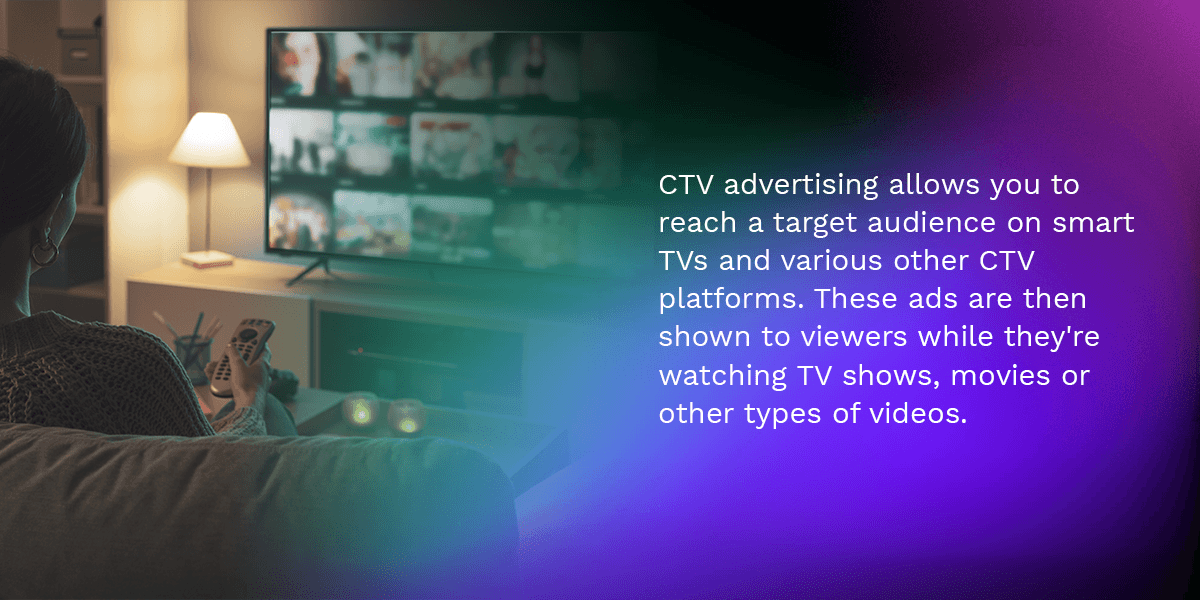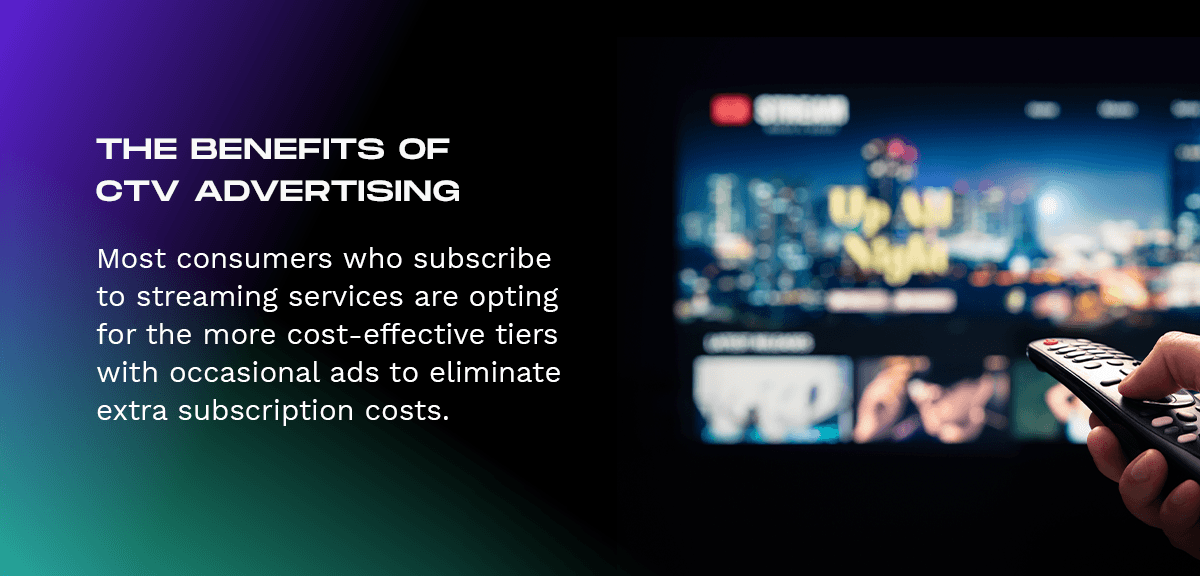“Television won’t be able to hold on to any market it captures after the first six months. People will soon get tired of staring at a plywood box every night.”
Guess Darryl F. Zanuck was far from right, considering how much TV-watching has changed since 1946. Today, there are more than 5 billion TV viewers worldwide. With so many options for enjoying personal screen time, TV advertising had to adapt to these changes — thus, connected TV (CTV) advertising was born.
But what does CTV mean exactly? How does CTV advertising work?
We have come a long way since having to adjust the antenna to get a clear black-and-white picture. It’s vital to keep up with TV-watching and streaming technology so your marketing can keep connecting with consumers in a meaningful way.
Understanding the basics of connected TV advertising
Before we get into what CTV in marketing is, let’s jump into the basics of CTV.
What is CTV?
CTV refers to the ability to stream content from the internet directly onto a television set. Unlike traditional TV that relies on broadcast signals or cable connections to satellites, CTV works with an internet connection to access a wide range of entertainment options. If you have a smart TV or another streaming device such as Roku, Chromecast or Amazon Fire TV Stick, you have a gateway to video streaming platforms along with music streaming services and even video games on your TV.
People love the flexibility and convenience of CTV as it allows you to choose what you want to watch from a vast library of on-demand movies and TV shows with the ability to pause and rewind.

What is a CTV ad?
You may have noticed the occasional ad appear in between episodes of your favorite Netflix show while watching it on TV. These are what one would call CTV ads. Traditional TV ads reach a broad audience on different channels, whereas CTV ads display on streaming platforms and are more targeted and personalized. As a media planner or marketer, you can use data on viewers’ demographics, interests and behavior to deliver ads that are more relevant to them through connected TVs. This is a similar approach to targeted social media ads.
Understanding CTV and OTT advertising
CTV and Over-the-Top (OTT) are related but the concepts are slightly different. CTV specifically refers to the hardware that allows you to stream content via the internet directly on your TV set. OTT, on the other hand, relates to how people stream content over the internet, which includes CTV but also extends to other devices beyond TV sets. OTT platforms include streaming services and apps that you can access on various devices, including smartphones, tablets, laptops and smart TVs.
Therefore, CTV ads are displayed on streaming platforms connected to a TV while OTT ads can pop up on any device where you’re streaming something over the internet. CTV ads are more targeted than OTT ads as they specifically focus on marketing to viewers who are streaming on their TVs.
Understanding the CTV television network
CTV ads show up among premium content provided by both free and paid streaming networks and publishers accessed through your TV, similar to what you would see on broadcast or cable channels. People can stream content and see these ads through smart TVs and other streaming devices, such as Roku, Apple TV, Chromecast, and Amazone Fire TV Stick. Three main entities play a key role in the CTV advertising space — subscription video on demand (SVOD), free ad-supported streaming TV (FAST) and live streaming services.
SVOD and ad-supported video-on-demand (AVOD) services are the most well-known for their subscription models. With SVOD, you pay a monthly or annual fee to access and view a library of content without being interrupted by ads. In the case of an AVOD, you can view the same library at a lower fee with ads popping up here and there. The AVOD option attracts cost-conscious viewers who look for cost-saving TV-watching alternatives. Some popular SVOD and AVOD platforms include:
- Apple TV+
- Disney+
- Hulu
- Max, previously HBO Max
- Netflix
- Paramount+
- Peacock TV
- Prime Video
FAST services allow people to watch their content for free and make revenue through advertising. The library selection on these platforms is usually limited and licensed from back catalogs of TV networks and studios. It’s a viable free alternative for those looking for older content. Some examples of FAST platforms are:
- Crackle
- Freevee (previously known as IMDb TV)
- Luto TV
- Roku Channel
- Tubi TV
- Xumo Play
Live streaming services provide real-time TV and broadcasting content with an internet connection. These platforms are great for CTV ads as ad campaigns can connect with viewers who enjoy the flexibility of streaming that gives that familiar live broadcasting TV experience. Live streaming service examples include:
- DirecTV Stream
- Fubo TV
- Philo
- Sling TV
- YouTube TV
The rise of CTV advertising
One can appreciate the growth and evolution of CTV advertising by remembering how TV adverts started and changed over the years.
- 1920s: This decade is known as when the first TV was invented, as well as when the first TV broadcast, TV networks and TV productions emerged.
- 1940s to 1960s: Ads focused on the features and benefits of products and were integrated into TV programs. Actors and show hosts often promoted products to their viewers, creating a link between programs and product ads.
- 1960s to 1980s: The first commercial satellite was sent into space for broadcasting purposes, giving rise to the first satellite TV. During this time, TV ads became more sophisticated and used storytelling to create a connection with viewers.
- 1980s to 2000s: With the arrival of cable TV and the expansion of different TV channels, advertisers were able to divide and target audiences more effectively with TV ads catered to different, but still broad, interests. This period also gave rise to direct response TV, where viewers could respond to TV ads via toll-free phone numbers.
- Early 2000s: This is the decade that started impacting traditional TV advertising. With the emergence of the digital age, computers, tablets and smartphones changed the way viewers interacted with and responded to ads. Digital recordings made it possible for people to watch what they wanted whenever they wanted to.
- 2005: Two major platforms gave rise to the era of streaming videos and created the base on which CTV would be built. iTunes allowed people to download and watch shows on their devices, while YouTube provided a platform for people to stream videos online or upload their own.
- 2007: One of the most significant moments in the history of CTV was when Netflix introduced its streaming service. This gave rise to other streaming services and networks entering the market, which revolutionized the whole industry.
- 2008 to present: Slowly but surely, people started changing their TV-watching behaviors and 2022 marked the year when more people used streaming services than cable TV. As the popularity of streaming services grows, marketers are making use of the advantages of CTV ads.
People prefer the on-demand streaming content and flexibility that streaming platforms provide. They can subscribe to platforms with content they’re interested in instead of paying for more costly bundled channel packages from cable or satellite TV subscriptions. Another factor for advertising agencies moving their budgets from traditional TV to CTV ads is the more comprehensive feedback on ad performance and viewer engagement. Even with more niche channels on TV, it remains a challenge to measure the actual performance of ads.
There’s nothing more valuable for marketers than the ability to receive and read data in order to gain a deeper insight into how ad campaigns perform. This feedback is valuable in improving future ads and includes better audience segmentation to reach the right people and create value for those who would appreciate it most.
How advertisers and brands can leverage CTV advertising
On-demand streaming services continue to gain massive popularity. The majority of the younger generation chooses streaming services over cable or broadcast TV. With more than half of Americans watching TV by using streaming services, now is the time for advertisers and brands to use CTV to their advantage.

How does CTV advertising work?
CTV advertising allows you to reach a target audience on smart TVs and various other CTV platforms. These ads are then shown to viewers while they’re watching TV shows, movies or other types of videos. The CTV campaign process consists of the following general steps:
- Strategizing: Start with identifying your goals for the CTV campaign and what you’ll need to execute it properly.
- Choosing a platform: Next, you’ll have to decide which platforms you want your ads to appear on. You have many providers to choose from between smart TV manufacturers, video streaming services and streaming sticks.
- Producing the ad: Most ads are 15 or 30 seconds long, although six-second ads started emerging recently. The 30-second ads are the most popular and provide the most return on investment (ROI). You may also want to consider incorporating interactive tools in your ads.
- Selecting your audience: Instead of selecting placements on a broadcasting channel, you can build custom audience segments and activate them across various platforms or streaming providers to reach the right audience.
- Launching and optimizing: It’s possible to reallocate budgets and optimize or extend ads, even after their launch, to ensure they go to the highest-performing channels.
- Measuring success: CTV advertising has a wide range of metrics to help evaluate the performance of any ad. These metrics include impressions, frequency, reach, completed views, clicks and conversions. Using valuable insights from these metrics can help to fine-tune strategies for future campaigns.
Cost of advertising on CTV
The cost of advertising on CTV is usually calculated as cost-per-thousand (CPM) views. It varies considerably and depends on a number of factors, including the:
- Platform
- Target audience
- Ad format
- Demand
The bigger your target audience and the higher the demand for a specific platform, the higher the cost will be. CTV ads have a greater CPM than other types of video ads, such as those on YouTube. However, because of the effectiveness of audience targeting and the platform used, most viewers view CTV ads until the end, which brings down the cost-per-completed-view (CPCV) significantly.
Another advantage of CTV ads is the ability to cap the frequency these ads are shown to users — unlike traditional TV ads that used to bombard viewers repeatedly on every channel.
The benefits of CTV advertising
Most consumers who subscribe to streaming services are opting for the more cost-effective tiers with occasional ads to eliminate extra subscription costs. Since the ads are usually short, it’s not as disruptive compared to traditional TV ads.

Additional benefits of CTV advertising for advertisers and brands include:
- Precise data-driven targeting: You can create audience segments on anything from geography and demographics to purchase behaviors. What’s more, you can use your own first-party data to reach previous website visitors and current customers.
- Broad viewer reach: CTV ads can reach viewers who have moved from traditional TVs to CTV platforms, therefore sharing a brand’s message with a broader spectrum of viewers.
- Localized IP-based targeting: CTV marketing makes it possible to reach viewers based on their location and, more specifically, their IP address. This allows brands that operate in certain areas to only reach viewers who are located nearby.
- Featured with high-quality content: Unlike online video platforms with user-generated content, CTV ads feature high-quality videos and shows similar to traditional TV. This ensures that CTV ads are shown in a brand-safe environment.
- High video completion rates: Viewers are less likely to skip or close ads while streaming content on a TV in a relaxed setting compared to other devices.
- Digital integration: CTV ads can be integrated with other online video advertising platforms after the initial launch, which enables viewers to re-engage with a brand on different channels.
- Detailed measurement and attribution: CTV advertising comes with more accurate metrics to measure the effectiveness of these ad campaigns.
- Enhanced viewer experience: Because ads are more targeted and customized, viewers can enjoy a personalized experience that’s relevant to their interests.
- Growing audience: With more viewers moving to streaming platforms, CTV campaigns have the opportunity to reach a growing audience.
Empower your CTV ads with Emodo
More consumers are “cutting the cord” on satellite and cable TVs. CTV is reshaping the way viewers consume videos, which is why digital media planners and advertising agencies need to embrace this modern way of advertising. Emodo is shifting with the changes in this digital age and will be focusing on providing clients with video-based ads that are immersive and creative. We would love for you to join us as we reimagine CTV ads and build memorable connections with consumers.
For more information on how we can help you take the first step into CTV advertising, get in touch with us online. We would love to hear from you!
MORE LIKE THIS



